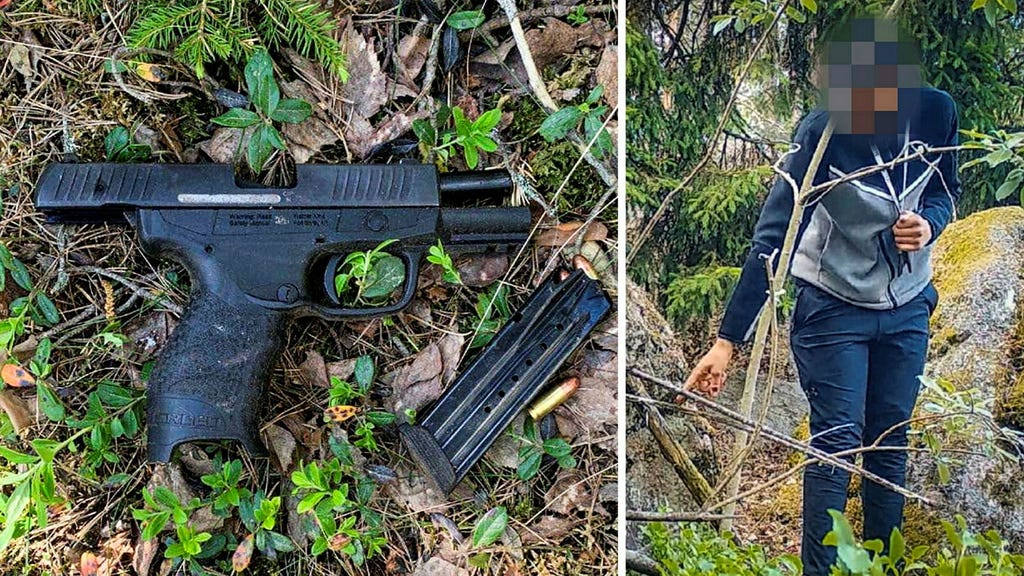In the summer of 2023, Swedish police in Västerås received an anonymous tip regarding suspicious activity in a local wooded area. A K9 unit was dispatched and discovered a semi-automatic pistol concealed within a rock crevice. Following standard procedure in such cases, the firearm was replaced with a replica and the location was placed under covert camera surveillance. Later that same day, a 17-year-old boy and two unidentified individuals were captured on camera approaching the crevice. Still images from the surveillance footage clearly showed the boy gesturing towards the exact location where the genuine firearm had been hidden. While the footage did not show the boy physically handling the replica, one of the unidentified individuals retrieved the replica and removed its magazine.
The apprehended 17-year-old denied any wrongdoing, claiming during questioning that his presence at the rock crevice was solely for the purpose of retrieving purchased narcotics. He stated that the weapon had been discovered by one of his companions. He struggled to explain the presence of his DNA on the firearm, offering the dubious explanation that he had briefly handled a similar weapon approximately a month prior, for a duration of only five seconds. This explanation, coupled with the surveillance footage and the discovery of the firearm, cast significant doubt on the veracity of his claims.
The Västerås District Court, while acknowledging the incriminating nature of the boy’s DNA on the weapon, initially acquitted him. Their reasoning hinged on the lack of definitive proof regarding who had placed the weapon in the crevice and how long it had been there. Consequently, they argued, it could not be conclusively established that the boy had exercised legal ”control” or ”possession” (rådighet) over the firearm, a crucial legal requirement for conviction. Furthermore, the court posited that the boy’s claim of seeking narcotics could not be definitively disproven.
However, the prosecution appealed the acquittal, and the case was subsequently heard by the Svea Court of Appeal. The higher court took a different perspective, concluding that the boy’s demonstrable knowledge of the hidden location indicated prior presence at the site or, at the very least, communication of the location to him by someone else. This, the Court of Appeal argued, established a sufficient connection between the boy and the firearm. They reasoned that before the pistol was swapped with the replica, the boy had ample opportunity to access and retrieve the real weapon from its hiding place, thereby fulfilling the legal requirement of ”control” or ”possession.” The court dismissed the boy’s explanation about searching for drugs as highly implausible and irrelevant to the case.
The Court of Appeal overturned the lower court’s ruling and convicted the boy, now 18 years old, of a serious weapons offense. Given his age at the time of the crime (17), he was sentenced to seven months of youth supervision, a less severe penalty than adult incarceration. The case highlights the complexities of prosecuting weapons offenses, particularly when dealing with circumstantial evidence and the legal nuances of establishing ”control” over a firearm. The use of replica weapons in police investigations also introduces a layer of complexity, raising questions about entrapment and the strength of evidence derived from such tactics.
This case echoes other similar instances in Swedish legal history where police have employed the tactic of substituting real firearms with replicas. In another case from 2023, two individuals, aged 16 and 18, were acquitted of attempted weapons offenses despite the use of a replica weapon in the investigation. Their acquittal was based on a precedent set by the Supreme Court of Sweden, further demonstrating the legal intricacies surrounding such cases. The Västerås case and others like it underscore the ongoing debate regarding the balance between effective law enforcement and protecting the rights of the accused, particularly in cases involving minors. The specific circumstances of each case, the interpretation of ”control,” and the use of replica weapons all contribute to the complex legal landscape of weapons offenses in Sweden.














